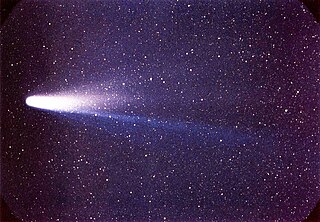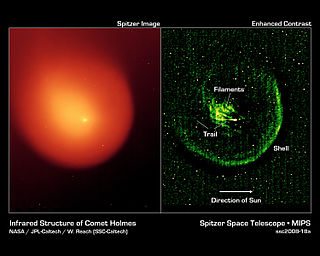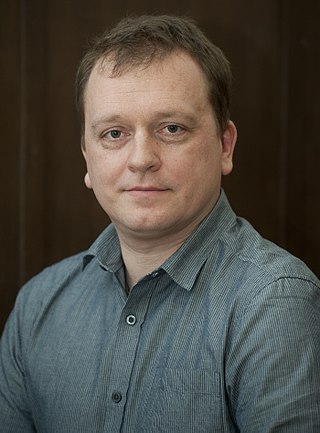
Sir Fred Hoyle FRS (24 June 1915 – 20 August 2001) was an English astronomer who formulated the theory of stellar nucleosynthesis and was one of the authors of the influential B2FH paper. He also held controversial stances on other scientific matters—in particular his rejection of the "Big Bang" theory (a term coined by him on BBC Radio) in favor of the "steady-state model", and his promotion of panspermia as the origin of life on Earth. He spent most of his working life at the Institute of Astronomy at Cambridge and served as its director for six years.
Physical science is a branch of natural science that studies non-living systems, in contrast to life science. It in turn has many branches, each referred to as a "physical science", together called the "physical sciences".

Natural science is one of the branches of science concerned with the description, understanding and prediction of natural phenomena, based on empirical evidence from observation and experimentation. Mechanisms such as peer review and repeatability of findings are used to try to ensure the validity of scientific advances.

Halley's Comet, Comet Halley, or sometimes simply Halley, officially designated 1P/Halley, is a short-period comet visible from Earth every 75–79 years. Halley is the only known short-period comet that is regularly visible to the naked eye from Earth, and thus the only naked-eye comet that can appear twice in a human lifetime. It last appeared in the inner parts of the Solar System in 1986 and will next appear in mid-2061.

Astronomy is a natural science that studies celestial objects and phenomena. It uses mathematics, physics, and chemistry in order to explain their origin and evolution. Objects of interest include planets, moons, stars, nebulae, galaxies, meteoroid, asteroid, and comets. Relevant phenomena include supernova explosions, gamma ray bursts, quasars, blazars, pulsars, and cosmic microwave background radiation. More generally, astronomy studies everything that originates beyond Earth's atmosphere. Cosmology is a branch of astronomy that studies the universe as a whole.

James Alfred Van Allen was an American space scientist at the University of Iowa. He was instrumental in establishing the field of magnetospheric research in space.

The coma is the nebulous envelope around the nucleus of a comet, formed when the comet passes near the Sun in its highly elliptical orbit. As the comet warms, parts of it sublimate; this gives a comet a diffuse appearance when viewed through telescopes and distinguishes it from stars. The word coma comes from the Greek κόμη (kómē), which means "hair" and is the origin of the word comet itself.

Fred Lawrence Whipple was an American astronomer, who worked at the Harvard College Observatory for more than 70 years. Amongst his achievements were asteroid and comet discoveries, the "dirty snowball" hypothesis of comets, and the invention of the Whipple shield.

David Clifford Jewitt is a British-American astronomer who studies the Solar System, especially its minor bodies. He is based at the University of California, Los Angeles, where he is a Member of the Institute for Geophysics and Planetary Physics, the Director of the Institute for Planets and Exoplanets, Professor of Astronomy in the Department of Physics and Astronomy and Professor of Astronomy in the Department of Earth, Planetary and Space Sciences. He is best known for being the first person to discover a body beyond Pluto and Charon in the Kuiper belt.
Big Splash could refer to:

Krisztián Sárneczky is a Hungarian teacher of geography and prolific discoverer of minor planets and supernovae, researching at Konkoly Observatory in Budapest, Hungary. He is a board member of the Hungarian Astronomical Association (HAA) and member of the American Association of Variable Star Observers, leader of the Comet Section of the HAA, and is a contributor in the editorial work of Hungarian Astronomical Almanach.
Guillermo Gonzalez is an astronomer, a proponent of the pseudoscientific principle of intelligent design, and a research scientist at the University of Alabama-Huntsville. He is a senior fellow of the Discovery Institute's Center for Science and Culture, considered the hub of the intelligent design movement, and a fellow with the International Society for Complexity, Information and Design, which also promotes intelligent design.
Extraterrestrial liquid water is water in its liquid state that naturally occurs outside Earth. It is a subject of wide interest because it is recognized as one of the key prerequisites for life as we know it and thus surmised as essential for extraterrestrial life.

The American Institute of Physics (AIP) instituted their Science Writing Award to "promote effective science communication in print and broadcast media in order to improve the general public's appreciation of physics, astronomy, and allied science fields." The winner receives $3000, and an engraved Windsor chair. The award is given in three broad categories: 1) science writing, 2) work intended for children, and 3) work done in new media. The AIP stopped issuing awards to three categories: 1) work by a professional journalist 2) work by a scientist, and 3) broadcast media

Discovery and exploration of the Solar System is observation, visitation, and increase in knowledge and understanding of Earth's "cosmic neighborhood". This includes the Sun, Earth and the Moon, the major planets Mercury, Venus, Mars, Jupiter, Saturn, Uranus, and Neptune, their satellites, as well as smaller bodies including comets, asteroids, and dust.

Comet Lulin is a non-periodic comet. It was discovered by Ye Quanzhi and Lin Chi-Sheng from Lulin Observatory. It peaked in brightness at magnitude between +4.5 and +5, becoming visible to the naked eye, and arrived at perigee for observers on Earth on February 24, 2009, and at 0.411 AU from Earth.

Mark Robert Showalter is a senior research scientist at the SETI Institute. He is the discoverer of six moons and three planetary rings. He is the Principal Investigator of NASA's Planetary Data System Rings Node, a co-investigator on the Cassini–Huygens mission to Saturn, and works closely with the New Horizons mission to Pluto.

The historical models of the Solar System began during prehistoric periods and are updated to this day. The models of the Solar System throughout history were first represented in the early form of cave markings and drawings, calendars and astronomical symbols. Then books and written records became the main source of information that expressed the way the people of the time thought of the Solar System.

Michael J. Mumma is an American astrobiologist at the Goddard Space Flight Center; he is best known for his investigation of the chemistry of comets.
Edwin (Ted) Bergin is a US astrophysicist who is currently the Professor of Astronomy at the University of Michigan (2019).















